White House Announces
"Startup America":Maybe a Good Time for FCC to "Rediscover" Section 7 and Start Complying with it?

The White House announced today “Startup America”, “a plan for winning the future by out-innovating, out-educating, and out-building the rest of the world.”
President Obama said, “Entrepreneurs embody the promise of America: the belief that if you have a good idea and are willing to work hard and see it through, you can succeed in this country. And in fulfilling this promise, entrepreneurs also play a critical role in expanding our economy and creating jobs. That’s why we're launching Startup America, a national campaign to help win the future by knocking down barriers in the path of men and women in every corner of this country hoping to take a chance, follow a dream, and start a business.”
NTIA’s parent, the Department of Commerce seems fully committed to the program
The Department of Commerce will expand the i6 Challenge to help foster the commercialization of clean technologies, and are finalizing a plan to allow entrepreneurs to request faster review of their patents, an initiative that should lower patent pendency times overall and speed the deployment of new ideas to the marketplace.
No indication whether NTIA will be involved just as there is no indication whether NTIA will follow the President’s earlier guidance that “each agency shall ensure the objectivity of any scientific and technological information and processes used to support the agency's regulatory actions.”
Readers may recall that FCC’s long term apparent disinterest in compliance with Section 7 of the Communications Act of 1934, as amended, has been a recurrent theme here. By contrast, let’s see what Commerce’s Patent and Trademark Office is doing as part of the new program:
U.S. Patent & Trademark Office (USPTO) Gives Applicants Greater Control Over Examination Timing and Enables Fast-Track Examination Within 12 Months: The USPTO is pursuing an Enhanced Examination Timing Control Initiative (Three-track Examination) to give innovators more control over the application processing and support a more efficient market for innovation. Under this initiative, applicants would be able to request prioritized examination (Track I), obtain processing under the current procedure (Track II), or request a delay lasting up to 30 months (Track III). Entrepreneurs who are seeking capital, or accelerated market penetration, may benefit from the prioritized examination offered by the Track I option. In contrast, those entrepreneurs working to commercialize more embryonic ideas may prefer the extended timeframe associated with Track III. Another benefit to entrepreneurs will be shorter overall examination queues.
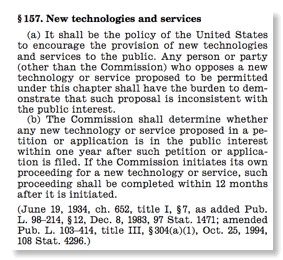
Section 7 is not a perfect piece of legislation. FCC has never implemented rules for administering it. FCC could ask Congress to amend it or even repeal it rather than just ignoring it. If anything, at present it is false hope for entrepreneurs and may discourage investment in entrepreneurial firms from VCs who get a cynical view of FCC’s treatment of startups in recent years.
But why don’t FCC and NTIA get on the President’s bandwagon and make life easier for wireless startups by promising decisions on some plausible schedule and real use of objective scientific information by NTIA in its presentations to FCC on shared spectrum - limited in public disclosure only by the need to protect properly classified information.
Technologies of Freedom and the Situation in Egypt
“Technologies of Freedom has enabled me to grasp for the first time the full impact of communications tools on freedom of expression.”
Thus it should not be surprising that the incumbent regime in Egypt’s first response to demonstrators was to turn off Internet and mobile communications in their country (NYTimes coverage of shutdown). It is an approach doomed to failure.
On the last page of the book, Pool wrote,
Electronic media, as they are coming to be, are disperse in use and abundant in supply. They allow for more knowledge, easier access, and freer speech than were ever enjoyed before. They fit the free practices of print. The characteristics of media shape what is done with them, so one might anticipate that these technologies will overwhelm all attempts to control them
Pool died in 1984 and never saw widespread Internet use, Facebook, or Twitter. But he brilliantly anticipated today’s media.
Recent EB Action Shows Slowness of Title III Technical Enforcement

On January 26, 2011, the Commission released two citations, shown above, for the marketing of cellular telephone jammers. Although your blogger has argued here that the Commission has the authority to authorize the use of cell phone jammers in prisons if it adopted new rules, it is unambiguous that the jammers being sold here were illegal because they had not equipment authorization and thus selling them violated Section 302 of the Communications Act.
In August 2009, I wrote here about an enforcement case involving the sale of a GPS jammer. At the time I used the following calendar to show the foot dragging involved in this action:

So how has timeliness improved? Note that in both the GPS and cell phone cases there was no question that the devices being sold were illegal and the sale violated Section 302. Note that violations of Section 302 are a misdemeanor and punishable as a criminal act under Section 501.
The two companies involved in the citation were DeadlyDeal.com and Comtrex Communications Ltd. Reading the citations carefully one sees that FCC was aware of DeadlyDeal.com’s marketing at least by April 8, 2009, yet did not even communicate with the company until February 18, 2010, 325 days later. In the case of Comtrex Communications Ltd., FCC was aware of the marketing at least by by June 9, 2009 and sent the first communications to the company September 29, 2009, 112 days later.
But both the GPS case and the present cellular cases ended up the same way with citations with no explicit penalty, except perhaps postage to respond to FCC letters. What type of deterrent is this for future illegal marketing by others?
On January 25, I gave an invited talk at the FCBA FCC Enforcement Brown Bag Lunch on the subject on unlicensed devices and enforcement. Here are the slides I used. I made the point that ever since the reorganization of the former FOB into Enforcement Bureau, the technical staff there has suffered from poor morale and poor leadership and that incumbent spectrum users need to advocate for more effective enforcement and leadership or major interference problems are likely to arise. This dilatory indecisive action in both the GPS jammer case and the cellular jamming case highlights how large numbers of interference causing devices could enter the marketplace before FCC takes any action. I urge the major spectrum incumbents and their trade associations to engage FCC senior leadership on how unacceptable this indecision is and the risks that result from it.
Furthermore, the lack of credible enforcement leads incumbents and NTIA to be reluctant to allow new technology near their bands for fear that noncompliant equipment will cause interference and there will be no timely FCC action. Thus the compliance status quo actually limits the Commission’s Title III policy options for new technologies!
IT GETS STRANGER!
Shortly after this was posted, Steve Crowley sent a comment to the blog pointing out that on the same day EB issued these 2 citations it issued a $10,000 NAL (fine) to an Arizona car dealer for unlicensed use of GMRS, a CB-like radio service than needs a license. Steve asks, “Is that worse than selling illegal jammers?”
So not only did EB act more promptly in the GMRS case than in the cell phone jamming cases and the GPS jamming case, they took decisive enforcement action rather than the toothless citation issued for these 3 jamming equipment cases. Where does CTIA and its membership stand on this type of enforcement? Should the 8th Floor ask for an explanation?
====
On a side issue, both the citations have this paragraph in them:
Jamming devices, however, cannot be certified or authorized because the main purpose of a jamming device is to block or interfere with radio communications. As noted above, such use is clearly prohibited by section 333 of the Communications Act. Thus, cell phone jammers, such as the Blocker, cannot comply with the FCC’s technical standards and therefore cannot be marketed in the United States.
This is the CTIA party line on its preferred interpretation of Section 333. The paragraph in the citations has no references to Commission decisions or court cases because there are none on this issue. This interpretation shows up in staff actions taken on delegated authority and in the case of these specific citation is irrelevant because sale of the devices violated Section 302 regardless of what Section 333 means. Their inclusion here is either because of ignorance or a desire to pander to CTIA. Repeating the same interpretation does not make it correct! The Commission has been sitting on the petition of South Carolina and 30 other states for over a year now. If this was such a clear issue they would have dismissed the petition per Section 1.401(e) of the FCC Rules months ago.
Comcast/NBC-Universal Merger:
Some Observations

On Tuesday, 1/18 FCC announced approval of the multibillion dollar merger of Comcast and NBC-Universal. These companies asked FCC for this approval on January 28, 2010 and FCC asked for public comment on March 18, 2010. At total of 33,736 items were filed in the docket file, 2,066 of which were formal enough to classified by ECFS as being other than “brief comments”. While the official Commission clock, shown above, shows the issue was resolve in 234 days and only 90 days of clock running time, a neutral observer such as your blogger might say the real turnaround was 355 days from initial request to approval. In any case, a remarkably fast period for the resolution of such a complex case. Our congratulations to the OGC Transaction Team for this accomplishment!
Now some observations:
1. You blogger is aware of no statutory requirement or even Commission rule requiring the Transaction Team’s nominal 180 day goal for issuing an “Order granting applications, granting applications with conditions, or designating applications for hearing (denials without a hearing are possible only in very limited circumstances).” He is aware that Section 7 of the Communications Act is the “law of the land” and has the following provision: “The Commission shall determine whether any new technology or service proposed in a petition or application is in the public interest within one year after such petition or application is filed.” Yet the Commission under chairman after chairman has consistently ignored the provision of Section 7.
•Why don’t Section 7 deliberations get any sort of attention for timeliness?
•Why did the recent AWS-3/M2Z Networks issue drift on without resolving the technical issues for over 4 years and then ended without ANY resolution?
•What message does this send to the financial community about the financing of innovative wireless technology?
•Is it possible to ever have a successful wireless startup like Qualcomm ever again if the Commission attaches no urgency at all to resolving technical issues about the new technology?
2. As part of the merger approval, there are several “targeted conditions and commitments” as well as “voluntary commitments” that are essentially regulatory requirements for the newly merger company. Many of these deal solely with programming and are of little professional interest to this audience. But since Comcast is a major ISP, some deal with networking issues. Your blogger does not question whether these conditions are the right conditions for today’s marketplace and technology. However, the technology and marketplace for ISPs is rapidly evolving and will likely be very different 5 years from now. As a historical note and analogy, let me point out that in 1943 Western Union merged with its last significant competitor and since telegraphy was a major serve at the time, Congress reacted to with analogous conditions for Western Union in Section 222 of the Communications Act. [Note, as explained below, this Section 222 has no relationship to the current Section 222 other than sharing a common 3 digit number.]

UPDATE
The Order approving the merger has now been released and totals 279 pages, a measure of the complexity of this issue. Yet if the Commission can deal with such complex issues in less than a year, why can’t it deal with its Section 7 statutory mandate? Just sayin’.
New Executive Order on "Improving Regulation and Regulatory Review"
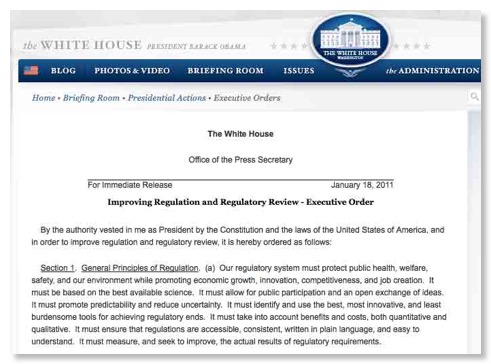
Today President Obama released Executive Order 13563 on the above topic. It is oddly reminiscent of Carter-era Executive Order 12044 that I reviewed here recently at the time of the death of Alfred Kahn and pointed out that the review it started was the origin of the ubiquitous Wi-Fi and Bluetooth. The new EO is similar in many ways, but also goes beyond the predecessor in others. Strictly speaking, it does not apply to FCC as an independent agency, but usually FCC has followed White House wishes on this general level.
The White House summarized the EO as follows:
In this Executive Order, the President requires Federal agencies to design cost-effective, evidence-based regulations that are compatible with economic growth, job creation, and competitiveness. It outlines following guiding principles:
- Cost-effective and Cost-Justified: Consistent with law, Agencies must consider costs and benefits and choose the least burdensome path.
- Transparent: The regulatory process must be transparent and include public participation, with an opportunity for the public to comment.
- Coordinated and Simplified: Agencies must attempt to coordinate, simplify, and harmonize regulations to reduce costs and promote certainty for businesses and the public.
- Flexible: Agencies must consider approaches that maintain freedom of choice and flexibility, including disclosure of relevant information to the public.
- Science-driven: Regulations must be guided by objective scientific evidence.
- Necessary and Up-to-Date: Existing regulations must be reviewed to determine that they are still necessary and crafted effectively to solve current problems. If they are outdated, they must be changed or repealed.
Note in particular the last 2 points. On the “science-driven” issue the EO states “Consistent with the President's Memorandum for the Heads of Executive Departments and Agencies,"Scientific Integrity" (March 9, 2009), and its implementing guidance, each agency shall ensure the objectivity of any scientific and technological information and processes used to support the agency's regulatory actions.” Hopefully this could improve the technical muddle the FCC often gets involved in spectrum policy deliberations. As a prominent attorney once told me, “Some technical questions really do have answers”.
The “necessary and up-to-date” provision, if aggressively implemented by FCC will remove anachronistic restrictions in spectrum technical rules from a bygone era. Wi-Fi comes from identifying such a problem: the implicit prohibition of spread spectrum in the FCC rules prior to 1985. Who knows what could come out of aggressive action here.
While this EO does not formally apply to FCC, it does apply to NTIA as an Executive Branch agency. It will be interesting to see how aggressively NTIA takes this guidance with respect to the last 2 points. Will NTIA try to make sure their decisions on federal systems and their restraints on FCC-regulated systems are “guided by objective scientific evidence”, not just secretive IRAC deliberations with no effective independent overview?
FAA Terminates Its "Spectrum Policy Grab" Rulemaking:
Highlights Fundamental Problem of NTIA Structural Weakness
Four years later, on July 21, 2010 the Federal Register published a Final Rule (R&O in FCC jargon) that goes into effect this week terminating this FAA rulemaking and taking no action at this time in the spectrum area. The NPRM proposed to require that anyone seeking a license or license modification in 13 different bands (some of which spanned more than one FCC allocation) must notify FAA independently of any FCC application. As the FHH CommLawBlog stated “the FAA lowered its conceit of attainable felicity a bunch, giving up on wide swaths of its 2006 proposal.” FAA withdrew its proposals for all bands but the FM broadcast band and made the following somewhat collegial statement:
The FAA, FCC and NTIA are collaborating on the best way to address this issue. A resolution of this issue is expected soon. Therefore, the proposals on FM broadcast service transmissions in the 88.0–107.9 MHz frequency band remain pending. The FAA will address the comments filed in this docket about the proposed frequency notice requirements and proposed EMI obstruction standards when a formal and collaborative decision is announced.
This problem has been around for at least 20 years and the FAA was so annoyed about perceived FCC and NTIA disinterest in their issues they made a successful end run around them and got some jurisdiction in this area in the Airport and Airway Safety and Capacity Expansion Act of 1987 (Pub. L. 100– 223 passed December 30, 1987) [FAA gave the legal background in p. 34030 of the NPRM, but they garbled the legal citations somewhat.]
Notwithstanding the about quote that “FAA, FCC and NTIA are collaborating” now, this whole incident shows US spectrum management policy at its worst. FCC and NTIA were both blindsided by the NPRM and it took 4 years to get any resolution, which in the end wasn’t much of a resolution. While NTIA thinks that it ”manages the Federal use of spectrum”, p. 42297 of the Final Rule states FAA’s viewpoint about “an existing process involving several Federal agencies with an interest in spectrum use, which NTIA oversees under the Department of Commerce.” So who is actually in charge?
The root cause of this problem is that FAA, which says it really cares about aviation safety where the other agencies don’t, also is caving in to pressure from the Aircraft Owners and Pilots Association (AOPA) - the “NRA” of the general aviation community. The ILS interference problems at the root of this issue are caused by “receiver-generated intermodulation” * in the ILS receiver when 2 or 3 strong FM broadcast signals are present that have a certain mathematical relationship to the ILS frequency. Both the receiver - regulated by FAA - and the FM broadcast stations are involved in the generation of the interference. Almost 20 years ago, ICAO developed receiver standards to minimize this problem.
Under pressure from AOPA, FAA has never made these ICAO receiver standards mandatory for all aircraft in the US. There is no indication that NTIA has ever pressured FAA on this issue.
NTIA has historically taken a hands off position to this problem even though NTIA claims it is responsible for “establishing and issuing policy regarding allocations and regulations governing the Federal spectrum use”. Historically, NTIA has been in favor of receiver standards for FCC-regulated services - but has been silent on other services where receiver problem impact FCC services.
So what is needed here is a real dialogue on how to split the burden of solving this problem between the FAA-regulated aircraft community and the FCC-regulated broadcast community with NTIA taken a forceful role in mediating a solution. However, the charter and legislation of NTIA dating back to the Carter Administration may make this impossible. The head of NTIA is an Assistant Secretary of Commerce and pragmatically assistant secretaries of smaller cabinet agencies do not tell other agencies how to spend their own money. This is the fundamental shortcoming of NTIA and results from its birth, not its present officials. Now many of us have observed the growth of the number of people in the Executive Office of the President with a strong interest in spectrum in the past 2 years. Hopefully this is a sign of the White House trying to exert some effective control over federal spectrum use which otherwise is mostly determined by user agency representatives meeting in secretive IRAC meetings. (They are so secretive, that I had trouble getting of minutes from a meeting that took place 25 years ago that I had attended!)
So FAA has backed off for now, but unless we get some real leadership in federal spectrum management this type of interagency problem will continue. Early in my FCC career, I both attended IRAC meetings from time to time and also represented the FCC at an interagency group on communications security (COMSEC). The Director, National Security Agency (DIRNSA in military jargon) has a national role in COMSEC that parallels NTIA’s role in spectrum policy. But the tone of the two meetings I attended was very different: DIRNSA sought the advice of federal agencies but made it clear that he was in charge and would consider the offered advice in making the final decision. By contrast, it was also clear at IRAC meeting that the various members were horse trading among themselves to decide what to tell NTIA to do. This is not leadership and spectrum is getting to be too precious to both the national economy and the national defense to base policy decisions on IRAC members horse trading among themselves for their own convenience. In Silicon Valley talk: “Adult supervision is desperately needed”.
I strongly believe that the White House needs a stronger role in spectrum policy even if it means partially undoing the creation of NTIA in 1977. I would transform the current NTIA Office of Spectrum Management into the IRAC Secretariat (which is a better description of most of its work at present) and leave most of the staff in Commerce while creating either a small decision making group in OMB or a new version of the old Office of Telecommunications Policy that reviews IRAC recommendations and has the resources to seek independent views of what is in the national interest, not the lowest common denominator of the IRAC membership.
----------
* Receiver-generated intermodulation is difficult to explain to people who are not radio techies because it is counter intuitive in many ways and can not be explained with simple analogies. It is the root cause of several complex spectrum policy issues in recent years such as the 800 MHz NEXTEL/public safety interference issue and the ongoing PCS H block controversy, WT Docket No. 04-356.
Excellence in Engineering: 2nd FCC Staffer Earns MSEE
Most other federal agencies that employ large numbers of engineers fund MS programs for new hires as to most private employers. Thus the existence of this program is key for FCC to stay competitive in hiring engineers. FCC had a similar program in the 1970s but it died during the Reagan era budgets
Recently, Benham (Ben) Ghaffari of OET became the second FCC staffer to receive this degree. Congratulations to Ben on this accomplishment and we should all hope this worthwhile program survives the inevitable budget crunch coming to FCC soon.
The first degree recipient, John Kennedy, was recently promoted to Chief, Spectrum Coordination Branch, OET Policy and Rules Division - the group that is the day-to-day interface with NTIA and IRAC.
NTIA Prison Jamming Report and the Meaning of §333: Why is NTIA So Sure that §333 Restricts FCC but not Them?
[Related NYTimes 1/3/11 article]
About a year ago the conference report on the FY 2010 Consolidated Appropriations Act contained language asking NTIA to study the prison cell phone jamming issue:
“To help State and Federal correctional authorities address this growing national problem, the conferees direct the National Telecommunications and Information Administration at the Department of Commerce, in coordination with the Federal Communications Commission, the Federal Bureau of Prisons and the National Institute of Justice, to develop a plan to investigate and evaluate how wireless jamming, detection and other technologies might be utilized for law enforcement and corrections applications in Federal and State prison facilities. The conferees strongly urge the NTIA, in coordination with the FCC, to investigate and evaluate detection or other technologies that do not pose a risk of negatively affecting commercial wireless and public safety services in areas surrounding prisons” -- H.Rept. 111-366 FY 2010 Consolidated Appropriations Act, Division B -Commerce, Justice, Science, & Related Agencies statement of managers, p. 17-18
As shown at left, the requested report was released December 29.
It appears that the Congress instructed NTIA to “investigate and evaluate how wireless jamming, detection and other technologies might be utilized” in prisons, but NTIA seemed captivated with the idea of parsing §333 for its meaning rather than focusing on the requested technical issues.
Here are some of NTIA’s legal findings in this report that was supposed to focus on technical issues:
- “Jamming interferes with 9-1-1 and authorized calls and violates the Communications Act of 1934 when performed by non-Federal officials.” - p. 1
- “Currently, the operation by non-Federal entities of transmitters designed to jam or block wireless communications violates the Communications Act of 1934, as amended. (The report then cites “47 U.S.C. § 301, 302a, 333. The FCC had reiterated this fact. See Sale or Use of Transmitters Designed to Prevent, Jam or Interfere with Cell Phone Communications is Prohibited in the United States, Public Notice, DA-05-1776, June 27, 2005 ...”) - p. 13
- “The Communications Act of 1934 prohibits non-Federal entities from intentionally interfering with radio signals. Many of the respondents reaffirm this as well. For example, the wireless industry expresses their concerns over deploying a device that violates the Communications Act of 1934.” - p. 16
- “The use of jammers by State or local prison officials is a violation of the Communications Act of 1934, and hence illegal. The FCC has denied previous requests to operate cell phone jammers at State correctional facilities.” - p. 18
- “The use of jammers by State or local prison officials is a violation of the Communications Act of 1934, and hence illegal. Jamming cell signals may be effective where legal in Federal applications ...” - p. 37
- (Jamming is) “Illegal for non-Federal entities; pending legislation for case-by- case jamming” - p. 39
- (Jamming) “Violates the Communications Act of 1934 when performed by non-Federal officials” - p. 40
Despite these repeated statements, even the 2005 public notice does not say FCC lacks the jurisdiction to authorize jamming, but simply FCC hasn’t and therefore it is illegal at present. (“The Communications Act of 1934, as amended, and the FCC rules prohibit the manufacture, importation, marketing, sale or operation of these devices within the United States”). NTIA seems to be trying very hard to espouse the CTIA viewpoint:
“With limited exceptions for certain federal agencies, signal jamming equipment is illegal due to Section 333 of the Communications Act because of those problems.”
So let’s look at this viewpoint. Here is §333:
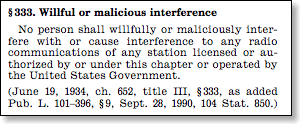
It was passed in 1990, not 1934, to criminalize certain jamming behavior in cases where the perpetrator had a valid radio license and thus could not be prosecuted under §301 - an example was the 1988 air traffic control jamming of numerous Eastern Airline flights by unionized US Air pilots during a labor dispute. Note that the legislative history of §333 does not mention anything about limiting the jurisdiction of either FCC or NTIA - it focuses on criminalizing unauthorized jamming such as the EAL/USAir jamming.
So why does NTIA and CTIA think it applies to anything FCC might do but has not impact on NTIA? Note that it is in Title III of the Communications Act, not in a law dealing with only FCC. Note that NTIA derives it own authority from this very same Title III: §305 gives the President parallel authority with respect to FCC saying:
Radio stations belonging to and operated by the United States shall not be subject to the provisions of sections 301 and 303 of this title.
Most of the spectrum powers of the Commission come from §303, so clearly federal spectrum users are exempt from such provisions. Note also that §333 is not the only law dealing with jamming. In 1986, only 4 years earlier, Congress passed 18 USC 1367 in the aftermath of the Captain Midnight/HBO satellite jamming incident recently discussed here :
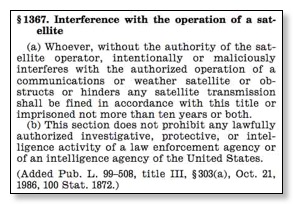
Note the language of 18 USC 1367(b) clearly exempting “any lawfully authorized investigative, protective, or intelligence activity of a law enforcement agency or of an intelligence agency of the United States” from its provisions. No such provision is in §333. So if §333 really means that FCC does not have the jurisdiction to authorize jamming, the obvious implication is that whatever §333 means it applies equally to FCC and NTIA absent any language differentiating them such as contained in §305 or 18 USC 1367.
Furthermore, if the 5 commissioners really felt that they lacked the jurisdiction to authorize jamming, they would have dismissed the petition filed by the South Carolina Department of Corrections and 30 other state correctional agencies in July/August 2009 under the provisions of 47 CFR 1.401(e) rather than letting it gather dust for almost a year and a half. It is truly bizarre that a petition from 30+ state public safety agencies has not been put out for public comment or dismissed after this much time!
But getting back to the technical aspects of the report, NTIA states”
Due to the limited deployment of the jammer transmitter at the Federal facility, NTIA could not draw conclusions from the field measurements assessing the potential of aggregate interference to in-band receivers if multiple jammer transmitters were operated throughout the facility. That is, NTIA could not determine the effects of the jammer on cellular and PCS devices outside the prison facility. - p. 9
Meaning the report is not really very conclusive on a key issue.
Let’s get to the physics of the issue: Both jamming and “managed access” will do their function if their signals are stronger than the signals from the cell site in that area. If in a given location within the prison the managed access or jamming signal is weaker than the cellular signal, then neither can prevent illicit calls by inmates. If at a given accessible by the public location outside the prison the jamming or managed access signal is greater than the carrier’s signal in a given band, then legitimate cell phone calls will be impacted. True in the case of 911 calls they will not be impacted, but all other calls will be impacted unless the cell phones are registered in the managed access system.
This explains the anecdote by FCC’s Adm. Barnett at the 9/30/10 forum on this issue that managed access worked so well at a demonstration that his secretary could not reach him outside the prison. Thus designing an antenna system for distributing the managed access or jamming signal so that it is greater than the cell base station signal everywhere inside the prison and weaker everywhere accessible to the public is an issue common to both systems. Without this careful RF distribution both systems have the potential of spottiness inside the prison and denial of service to the general public outside - although managed access does protect 911 in both cases. It is a problem that is much easier for rural prisons with large buffer areas around them and probably impossible for urban facilities like the Arlington Country Jail which is located in a high rise in an office area. Thus it is odd that Table 7-1 of the NTIA report describes jamming as requiring “(e)xtensive testing prior to implementation” - both system will need comparable testing to verify effectiveness inside prison and lack of impact outside prisons.
The same Table 7-1, on the other hand says about the cost implications of managed access: “Depends on coverage, frequency bands, etc; can be at no-cost to prison authority or vary based on complexity of site; infrastructure costs”. So why is managed access possibly “free”? Most states have contract with high price OSPs (operator service providers) for prison pay phones who charge high rates for inmates’ calls - the original “captive audience”. In the Mississippi test the OSP is paying for he managed access system because it “eliminates competition” resulting in higher revenues although further rate hikes for calls were being considered..
While managed access might appear to NTIA to be “free”, recidivism is a major issue in our prison systems and has a huge impact on society resulting in both high crime rates and high incarceration rates. Indeed, the societal cost of recidivism probably dwarfs the sums involved in this cell phone issue. Studies have shown that increased inmate contact with family can decrease recidivism but inmates and their families and in a poor position to bear the cost of prison payphone calling charges much higher than the rest of the population pays. South Carolina has low calling charges by order of the state legislature where the measure had bipartisan support. The federal Bureau of Prisons also has low calling charges for its inmates. So accounting for the cost of managed access purely by looking at out of pocket costs that are zero because prison OSPs pay for it out of “monopoly rents” is myopic. Indeed, prison OSPs might well want to pay for jamming systems if they were cheaper than managed access and allowed by FCC. (A high FCC official was surprised recently when I mentioned that these prison OSPs were actually subject to FCC Title II regulation and that FCC could reinstate price regulation in this special case where deregulation has failed. Decreasing the exorbitant charges of prison OSPs would probably decrease the illicit cell phone problem since they would then be less attractive to inmates interested in only family contact.)
The real issue here is that the cellular industry is rightly very concerned about jammers in nonprison contexts. There is recurring interest among local law enforcement to use jamming for tactical reasons. Jamming in non-law enforcement contexts is a recurring problem. CTIA’s preferred interpretation of §333 neatly solves both problems. But the continued impasse over prisons is endangering lives. Why can’t we draw a bright line between the prison case where lives are at stake now and these other cases? How many more innocent people have to die before we allow prison authorities the flexibility to protect their staff and the public subject to strict, responsible guidelines that safeguard public communications systems.

Carl Lackl, Jr. (l) a Baltimore witness murdered as a result of a prison cell phone call.
Capt. Robert Johnson (r) South Carolina Department of Corrections, shot 6 times
at his home as a result of a prison cell phone call.

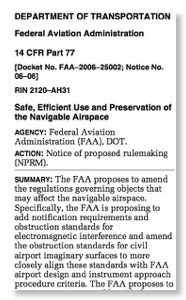
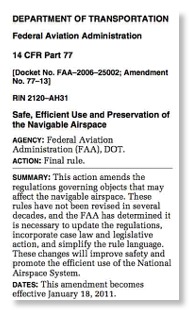



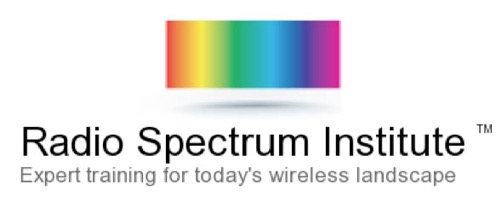


![Validate my RSS feed [Valid RSS]](valid-rss-rogers.png)

